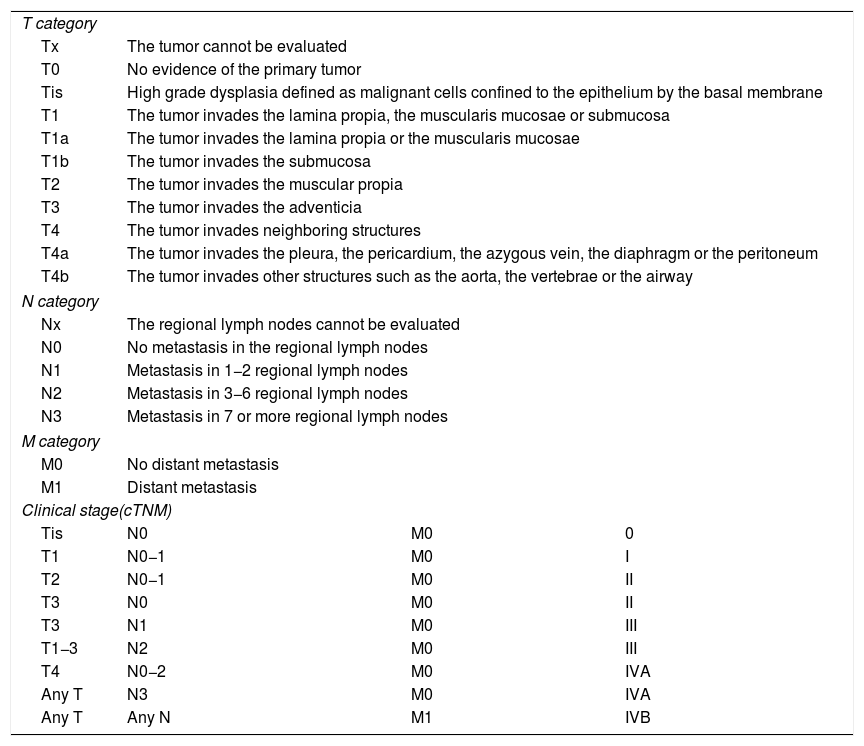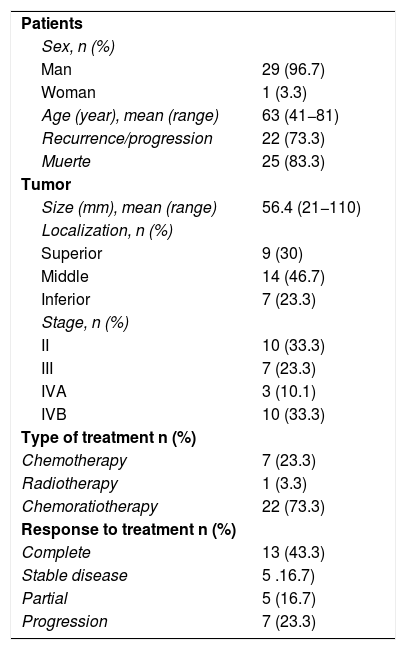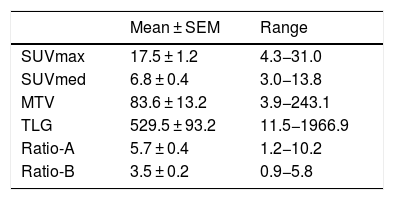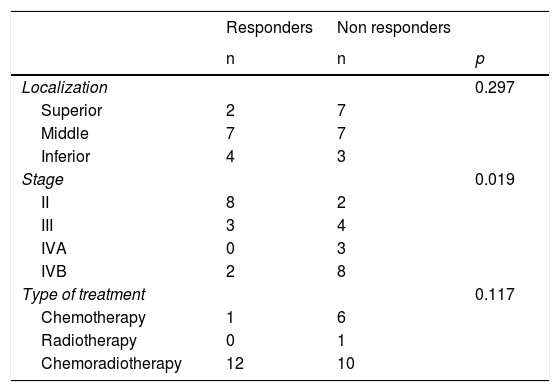To determine the utility of [18F]FDG PET/CT quantitative parameters as prognostic factors for the response to neoadjuvant treatment, progression-free survival (PFS) and cancer-specific survival (CSS) in patients with esophageal squamous cell carcinoma (SCC).
Material and methodsThirty patients (29 men) diagnosed with SCC were retrospectively evaluated over a 6-year interval. Metabolic parameters were determined: maximum SUV (SUVmax), mean SUV (SUVmed), metabolic tumor volume (MTV) and total lesion glycolysis (TLG) from baseline PET/CT study. After treatment with chemotherapy and/or radiotherapy, response to treatment and patient survival were assessed. The comparison of parameters between groups of responders and non-responders was carried out using a Mann-Whitney U test ROC curves and the Kaplan-Meier method were used for analysis of prognostic factors and survival curves.
ResultsThe average follow-up was 22.4 months, with 22 recurrence-progressions and 25 deaths. Significant differences were demonstrated between responders and non-responders with respect to tumor size, MTV and TLG. Survival analysis found significant differences for SCE and CSS depending on these three parameters.
ConclusionMetabolic parameters MTV and TLG, and tumor size were prognostic factors for neoadjuvant treatment response, PFS, and CSS in patients diagnosed with SCC. Neither SUVmax nor SUVmed were predictive for any of the evaluation criteria. Results could help to personalize patient treatment.
Determinar la utilidad de los parámetros cuantitativos de la PET/TC con [18F]FDG como factores pronósticos para la respuesta al tratamiento neoadyuvante, la supervivencia libre de progresión (SLP) y la supervivencia cáncer específica (SCE) en pacientes con carcinoma de células escamosas de esófago (CCE).
Material y métodosSe valoraron retrospectivamente 30 pacientes (29 hombres) diagnosticados de CCE durante un intervalo de 6 años. Se determinaron los parámetros metabólicos SUV máximo (SUVmax), SUV medio (SUVmed), volumen metabólico tumoral (MTV) y glicolisis tumoral total (TLG) del estudio PET/TC al diagnóstico. Tras tratamiento con quimioterapia y/o radioterapia, se valoró la respuesta al tratamiento y la supervivencia de los pacientes. La comparación de parámetros entre grupos de respondedores y no respondedores se realizó mediante la prueba U de Mann-Whitney. Las curvas ROC y el método de Kaplan-Meier se utilizaron para el análisis de factores pronósticos y curvas de supervivencia.
ResultadosEl seguimiento medio fue de 22,4 meses, produciéndose 22 recurrencias-progresiones y 25 exitus. Se demostraron diferencias significativas entre respondedores y no respondedores con respecto al tamaño tumoral, el MTV y la TLG. El análisis de supervivencia halló diferencias significativas para SCE y SLP dependiendo de estos tres parámetros.
ConclusiónLos parámetros metabólicos MTV y TLG, así como el tamaño tumoral, fueron factores pronósticos para la respuesta al tratamiento neoadyuvante, la SLP y la SCE en pacientes diagnosticados de CCE. Ni el SUVmax ni el SUVmed fueron predictores para ninguno de los criterios de evaluación. Los resultados permitirían personalizar el tratamiento de los pacientes.
Article

Revista Española de Medicina Nuclear e Imagen Molecular (English Edition)













